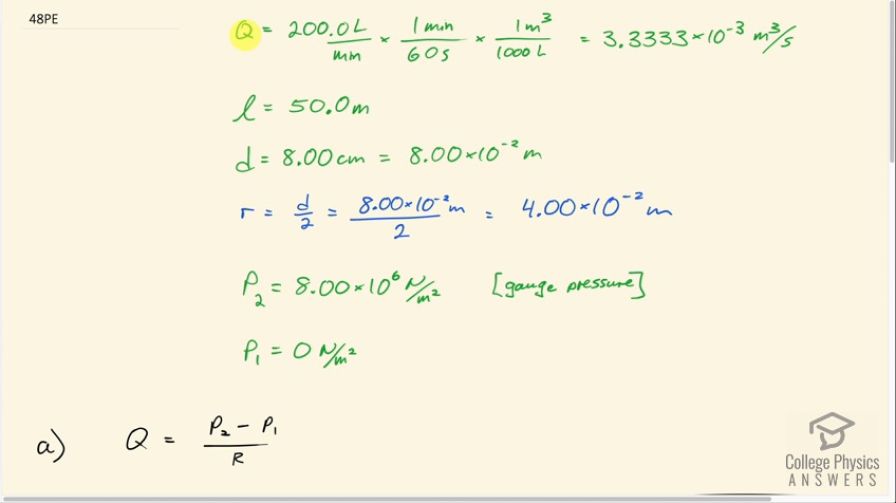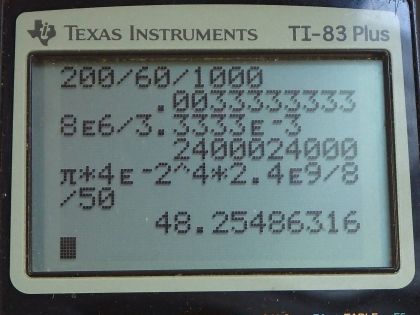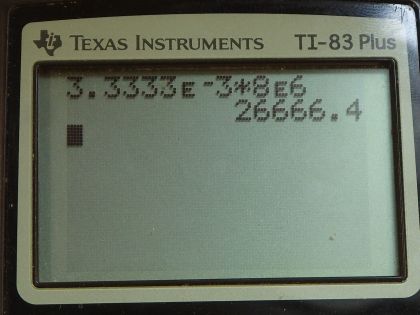Question
Concrete is pumped from a cement mixer to the place it is being laid, instead of being carried in wheelbarrows. The flow rate is 200.0 L/min through a 50.0-m-long, 8.00-cm-diameter hose, and the pressure at the pump is . (a) Calculate the resistance of the hose. (b) What is the viscosity of the concrete, assuming the flow is laminar? (c) How much power is being supplied, assuming the point of use is at the same level as the pump? You may neglect the power supplied to increase the concrete’s velocity.
Final Answer
Solution video
OpenStax College Physics for AP® Courses, Chapter 12, Problem 48 (Problems & Exercises)

vote with a rating of
votes with an average rating of
.
Calculator Screenshots
Video Transcript
This is College Physics Answers with Shaun Dychko. Concrete is being pumped by a pumper truck through a hose to the concrete form where it's going to be delivered. And there's a bunch of things we have to write down in order to begin this question. So the volume flow rate, we're told, is 200 liters per minute. And we're going to convert that into cubic meters per second because this is an M.K.S Unit, Meters Kilogram Second unit that we will need for our formulas. So we multiply by one minute for every 60 seconds and then by one cubic meter for every 1000 liters and we’re left with cubic meters per second. And that's 3.3333 times 10 to the minus three cubic meters per second. The length of the hose is 50 meters, its diameter is eight centimeters. And the prefix ‘centa’ means times 10 to the minus two. But we want to know the radius because that's we're going to use in our formulas. We divide that diameter by two and we get 4.00 times 10 to the minus two meters. The pressure at the beginning of the hose or at the pump is eight times 10 to the six newtons per square meters. We assume that the gauge pressure, in which case the pressure at the end is zero gauge pressure. So part ‘A’ asked us the resistance of the hose. So the volume flow rate is the difference in pressure between the ends of the hose divided by the resistance. And we can solve this for R by multiplying by R over Q on both sides. And so we get the resistance is the difference in pressure divided by the volume flow rate. So that's eight times 10 to the six newtons per square meter, minus zero divided by 3.3333 times 10 to the minus three cubic meters per second, which is 2.40 times 10 to the nine newton seconds per meter to the fifth, which is very strange unit. But it's true because here we have newtons per meter squared and then we're dividing that by meters cubed per second. But instead of dividing a fraction by a fraction, that's multiplied by its reciprocal of seconds per meters cubed. And we end up with meters to the fifth in the denominator here. Part ‘B’ is what is the viscosity of the concrete? Assuming the flow is laminar. So this is Perseus law, for laminar flow, which says that the resistance is eight times the viscosity times the length of the hose divided by pi times the radius to the power of four. So we can solve this for a new, the viscosity by multiplying both sides by r to the fourth times pi divided by eight times l. And so we get the viscosity then is pi times the radius to the power four times the resistance and it's a bit confusing because they're both letter R but the resistance in capital and divided by eight times the length. So that's pi times four times 10 to the minus two meters radius of the hose to the power of four times 2.4 times 10 to the nine Newton seconds per meters to the fifth that we found in part ‘A’ for the resistance divided by eight times 50 meters length. And that is 48.3 pascals seconds. You could also say Newton seconds per meters squared. But it's more common to write viscosity in units of Pascal seconds. Part ‘C’ says how much power is being supplied by the pump to make this concrete float through the tube. So power is the volume flow rate times the pressure in the hose, plus one half times the density of the fluid times its speed squared plus the density of fluid times g times the change in height of the fluid. Now we're told that the concrete is being delivered to a height at the same level as the pump. And so we can ignore this h term. This is zero. And we're also told that to neglect the power needed to give this concrete kinetic energy, that's what this term represents is the kinetic energy of the fluid. So V is negligible. In other words, which case this is also zero. And so our power formula is just volume flow rate times the pressure. And so that's 3.3333 times 10 to the minus three cubic meters per second times eight times 10 to the six newtons per square meter, which is 2.67 times 10 to the four watts.

